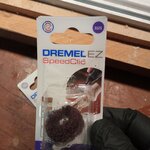penicillin
Member
- Joined
- Feb 27, 2019
- Messages
- 1,036
Yeah, this is the penturning website, but this forum is the best fit where I am already a member.
My folding knife kits are coming out with too many heavy scratches on the metal "spines" that are sandwiched between the two wood scales. I cut the scales on the bandsaw close to the shape of the handle, glue them to the handle, and then sand until the wood is flush with the metal parts. It is the same method that I see in YouTube videos. The people in the YouTube videos don't show the "spines" much, but when I catch a glimpse, they seem to have the same scratches that I am trying to avoid. I want to upgrade my work from scratched to polished, the way they look when the parts come out of the package.
I've thought about trying to rig a flush trim router bit to match the wood to the metal using a bearing, but that would mean gluing and trimming the first scale separately first, then gluing the second scale. I'm not sure if that would work.
I've thought that perhaps there is a way to sand with finer grits up to the point of polishing the metal; would that work?
I am out of ideas, and I would like to make better knives. Any suggestions from people with more knife making experience would be welcome.
I am not a "knife person", so please forgive any incorrect terms or confusion. All I want is to make a few gifts with the best quality I can achieve, considering that I am starting out with a mix of ordinary folding knife kits from Rockler and Woodcraft. They are nothing special or fancy.
My folding knife kits are coming out with too many heavy scratches on the metal "spines" that are sandwiched between the two wood scales. I cut the scales on the bandsaw close to the shape of the handle, glue them to the handle, and then sand until the wood is flush with the metal parts. It is the same method that I see in YouTube videos. The people in the YouTube videos don't show the "spines" much, but when I catch a glimpse, they seem to have the same scratches that I am trying to avoid. I want to upgrade my work from scratched to polished, the way they look when the parts come out of the package.
I've thought about trying to rig a flush trim router bit to match the wood to the metal using a bearing, but that would mean gluing and trimming the first scale separately first, then gluing the second scale. I'm not sure if that would work.
I've thought that perhaps there is a way to sand with finer grits up to the point of polishing the metal; would that work?
I am out of ideas, and I would like to make better knives. Any suggestions from people with more knife making experience would be welcome.
I am not a "knife person", so please forgive any incorrect terms or confusion. All I want is to make a few gifts with the best quality I can achieve, considering that I am starting out with a mix of ordinary folding knife kits from Rockler and Woodcraft. They are nothing special or fancy.

